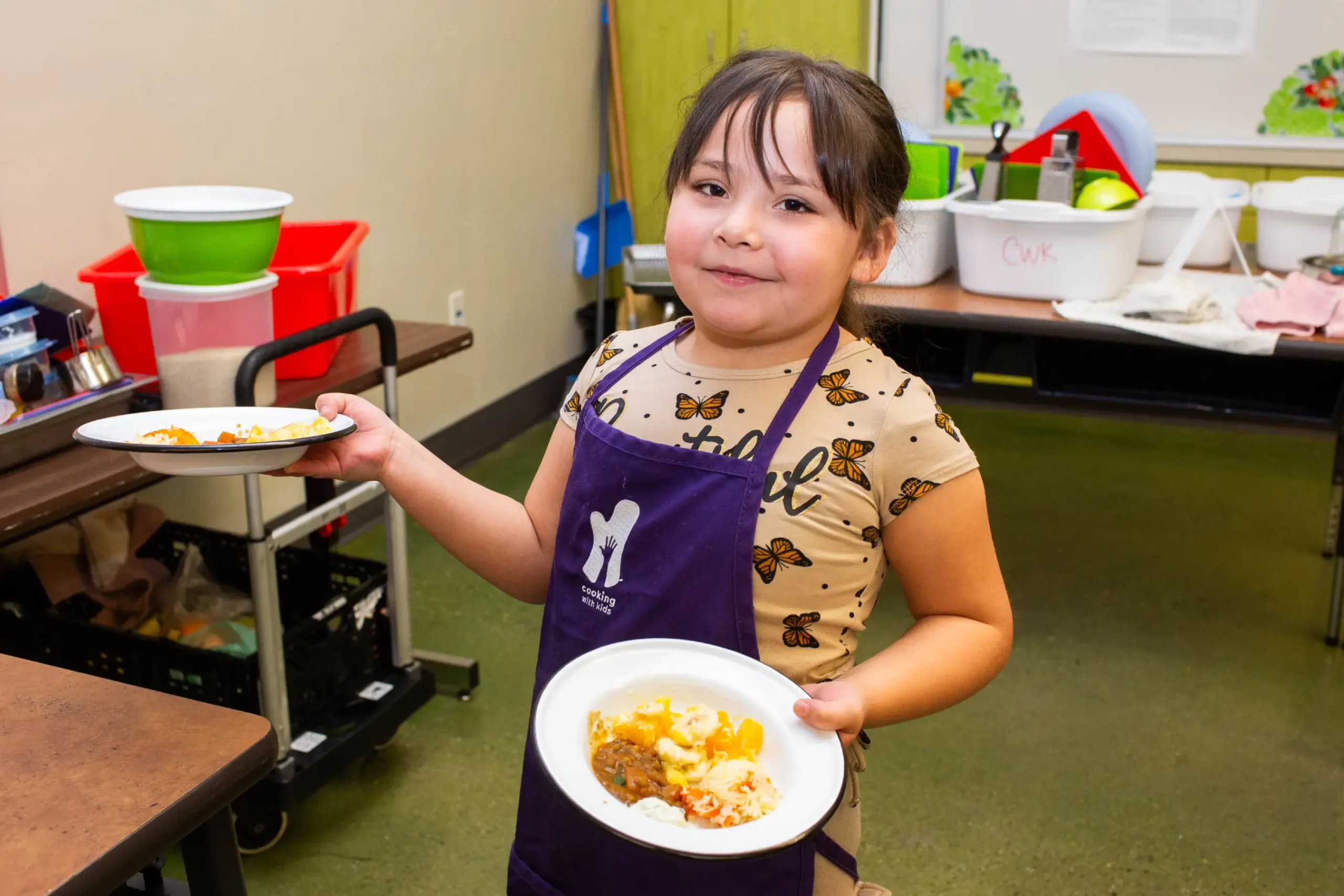Serving food. Photo credit: Kerry Sherck
Safe and Fun Ways to Involve Kids in Your Next Celebration
By Rachel Shreve
At Cooking with Kids, we know the benefits of inviting kids into the kitchen any time of year, and the holidays are no exception. The holidays can be a special time for families to come together, learn about traditions (and sometimes start new ones!), build intergenerational relationships, and create lasting memories. Involving children in the preparation of a meal during this time allows kids of all ages to contribute to their holiday experience in a meaningful way. Plus, it can be lots of fun.
Here are some age-appropriate and safe ways kids can help with holiday meals.
1. Setting the Table
Setting the table is one of the simplest yet most important tasks. Kids of all ages can help with this job. Young kids can place napkins, forks, and spoons, and older kids can arrange plates, glasses, and decorative centerpieces. Let them get creative with folding napkins or adding personalized touches, such as decorated placemats or place cards, to make it extra special.
2. Washing Vegetables
Washing fruits and vegetables is a safe and straightforward task that younger children can handle. Have them stand on a step stool by the sink and show them how to scrub veggies like carrots, potatoes, and peppers.
3. Measuring Ingredients
Measuring ingredients is a practical way to involve kids while teaching them basic math skills like fractions and quantities. Plus, it helps with precision in cooking and baking. With supervision, even little kids can help measure dry ingredients like flour, sugar, and spices, and liquids like milk and broth.
4. Mixing Ingredients
Mixing and stirring ingredients are essential steps in many recipes, and it’s a task that gives kids a sense of ownership over the meal. They’ll love knowing they helped create a dish. Provide them with a sturdy spoon or a whisk and let them stir to their heart’s content. (Just make sure it’s not a recipe that will be compromised by overmixing—mashed potatoes, tamale masa, and salad dressing can all handle some extra enthusiasm.)
5. Tearing Lettuce or Herbs
Tearing lettuce for salads or herbs for seasoning is a safe, hands-on task for younger kids. They can see the direct result of their work in the final dish, boosting their confidence. Show kids how to carefully tear lettuce into bite-size pieces or pluck herbs like parsley or basil. Avoid using sharp knives at this stage and let them use their hands.
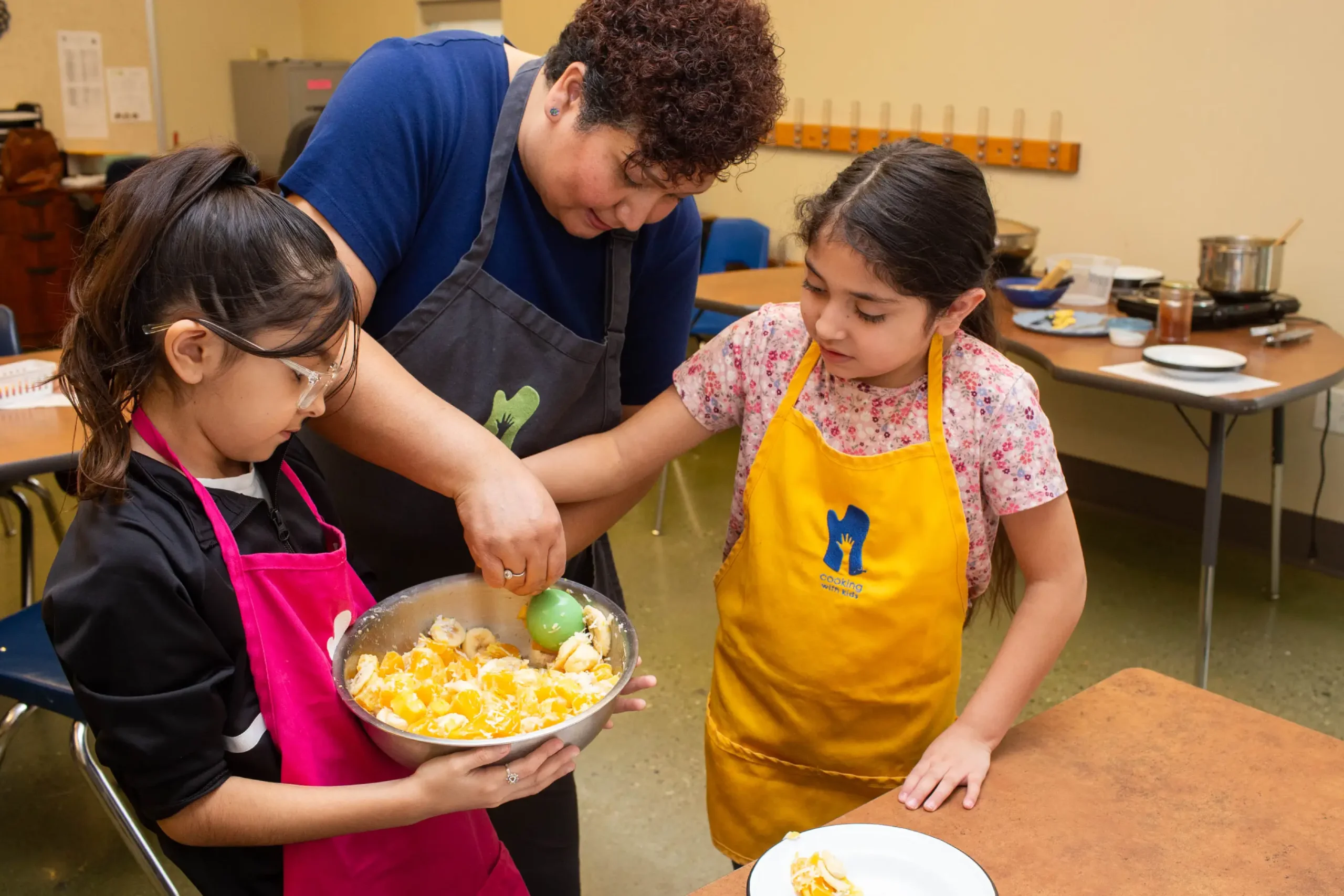
With some guidance, kids can help plate food to be served at celebrations. Photo credit: Kerry Sherck
6. Kneading Dough
Kneading dough for breads or rolls is an enjoyable, tactile task that also develops motor skills. Plus, kids love getting their hands a little messy. Teach them the basics of kneading by folding and pressing the dough. Let them work with small batches and encourage them to keep kneading until the dough is smooth and elastic.
7. Peeling or Cutting Fruits and Vegetables (With Supervision)
For slightly older children, peeling vegetables or learning to safely use a knife can be a fun (and supervised) activity. These tasks are also a step up in responsibility and allow older kids to practice fine motor skills.
Peeling Tips:
- Use a safe, child-friendly peeler and show them the correct technique: Always peel away from the hand holding the food, and, depending on the peeler, either to the side or down and away from your body.
- When peeling with beginners, opt for vegetables like cucumbers and zucchinis that are easier to hold and peel while holding flat on a cutting board.
Cutting Tips:
- Many soft foods can be cut with a butter knife, and there are also kid-safe knives available that are designed to cut through food without being sharp enough to harm fingers.
- Even when using practice knives, make sure to emphasize safety and proper technique.
- Once kids have had some practice, mincing garlic can be a safe way to introduce a sharp knife, since kids can pinch the top of the knife with both hands and mince with an up and down motion (no little fingers near the blade).
8. Helping with Baking
Baking is often a big part of holiday meals, and baking together can be a wonderful way to pass down family recipes and traditions. Kids of all ages can help measure and mix, and with help, even the littlest of hands can roll dough, press cookie cutters, and decorate baked goods.
9. Being in Charge of a Simple Recipe
Many holiday dishes, such as salads, fruit bowls, and side dishes like cranberry sauce, are simple enough for kids to prepare independently (with a smidge of guidance). You can give them easy recipes with just a few ingredients and let them follow the steps. Younger kids can make a festive fruit salad by combining chopped fruit. Older kids can try their hands at holiday-themed treats like cookies and no-bake desserts.
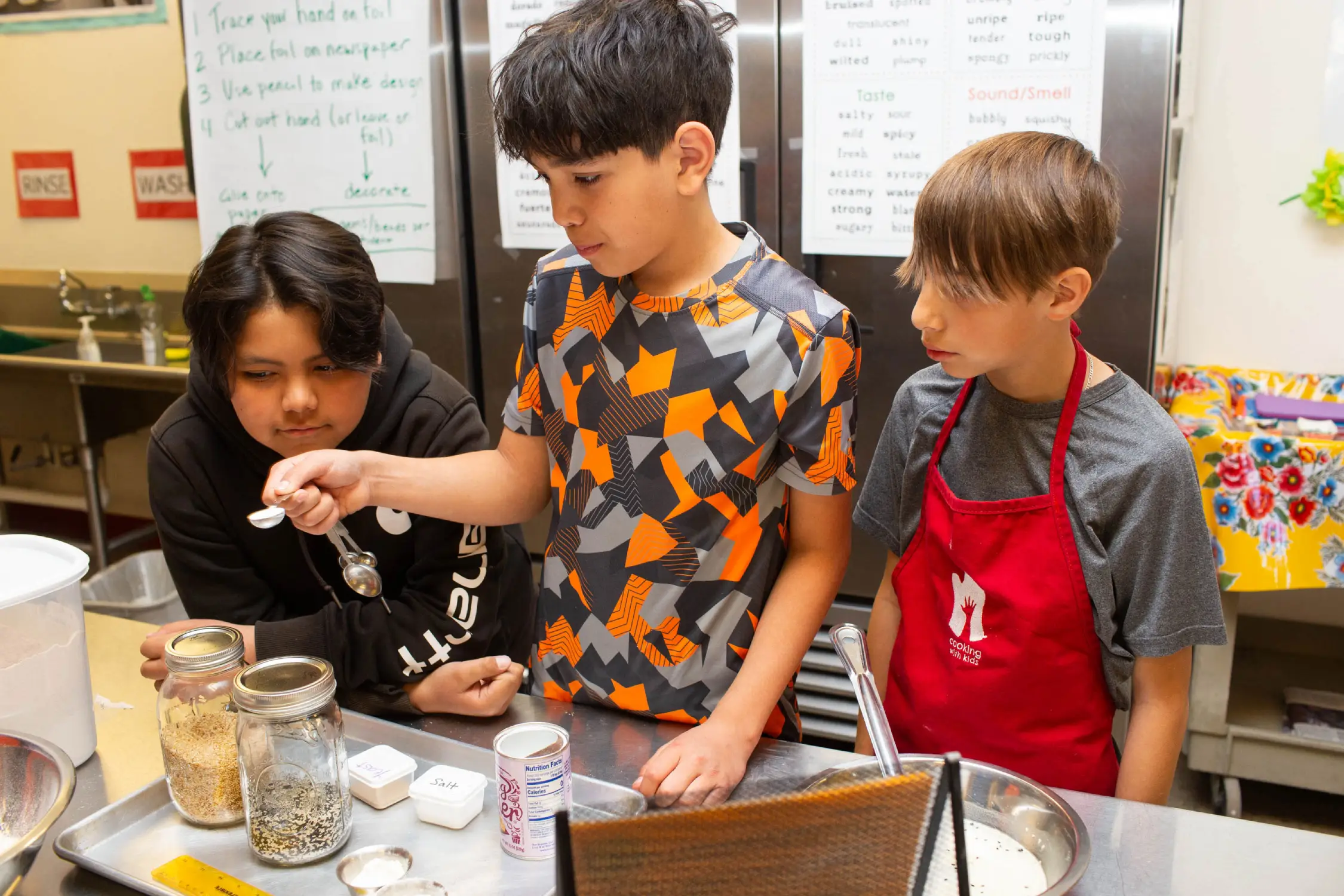
Fifth graders measuring ingredients for flatbread. Photo credit: Kerry Sherck
10. Clearing the Table
Once the meal is finished, cleaning up is just as important as preparing the meal. Children can help clear plates, take out the trash, wipe down surfaces, and even wash the dishes. This teaches responsibility and the importance of teamwork in family celebrations.
11. Creating Holiday Food Traditions
Finally, one of the most meaningful ways kids can help is by being involved in creating or continuing family traditions. Whether it’s a secret family recipe passed down through generations or a new dish you create together, the holidays are a great time to make cooking memories that last. Consider letting kids choose a dish they’d like to make every year, or involve them in planning the meal, so they can feel a deeper connection to the holiday celebration.
Safety Tips to Keep in Mind
- Always supervise children closely when they are in the kitchen, especially when they are near sharp objects or hot surfaces.
- Assign age-appropriate tasks to ensure your child is both safe and successful. Younger kids should focus on simple, low-risk activities, while older kids can handle more advanced tasks.
- Teach hygiene from the start: ensure kids wash their hands before handling food and after touching raw ingredients like eggs and meat.
- Encourage creativity by letting children take charge of specific elements, such as dessert decoration or making place cards. Their unique touch can make the meal even more special.
Check out cookingwithkids.org for recipes and kid-friendly how-to videos with tips about knife safety, measuring, using herbs and spices, and more.
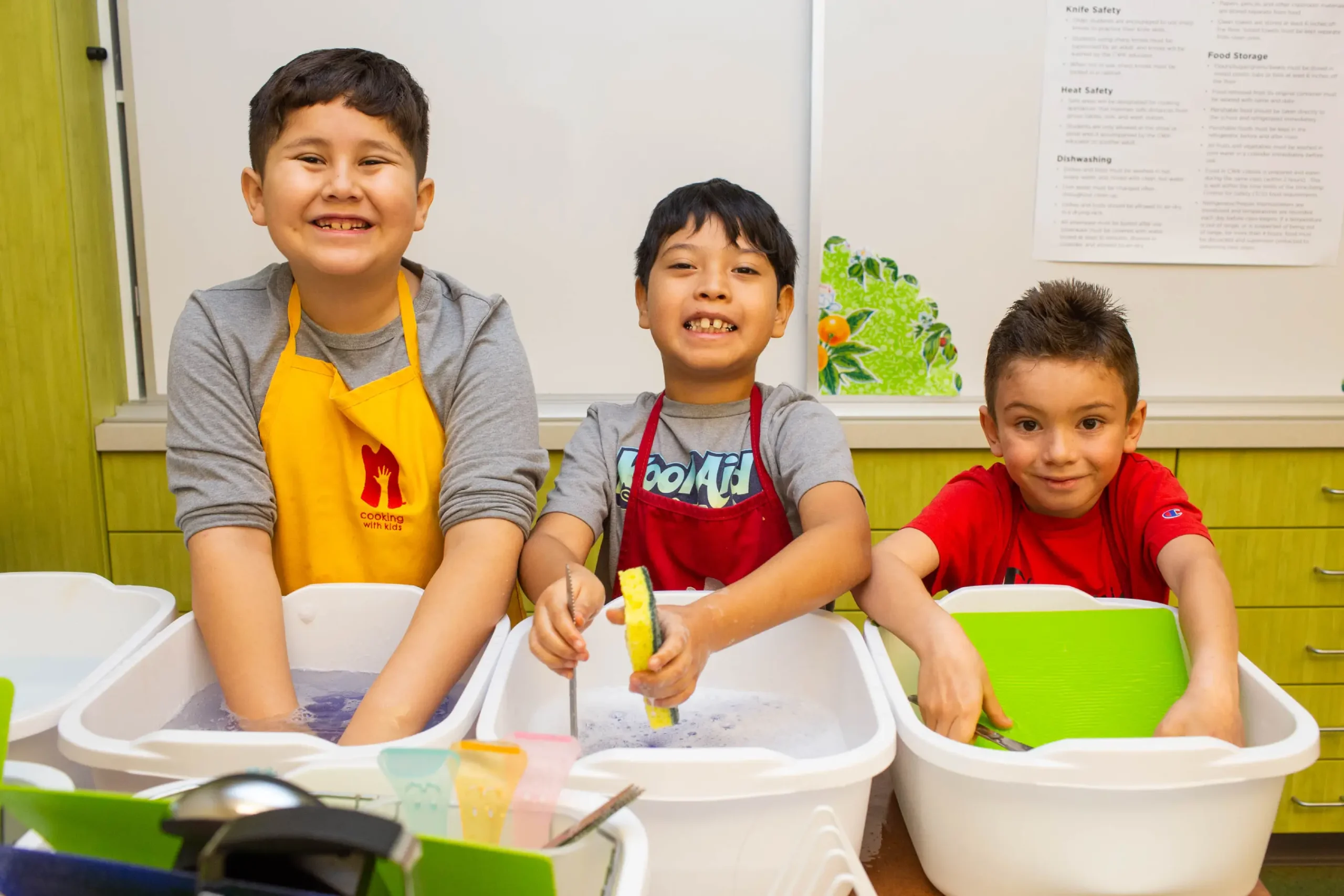
Washing dishes is a favorite activity in Cooking with Kids classes. Photo credit: Kerry Sherck
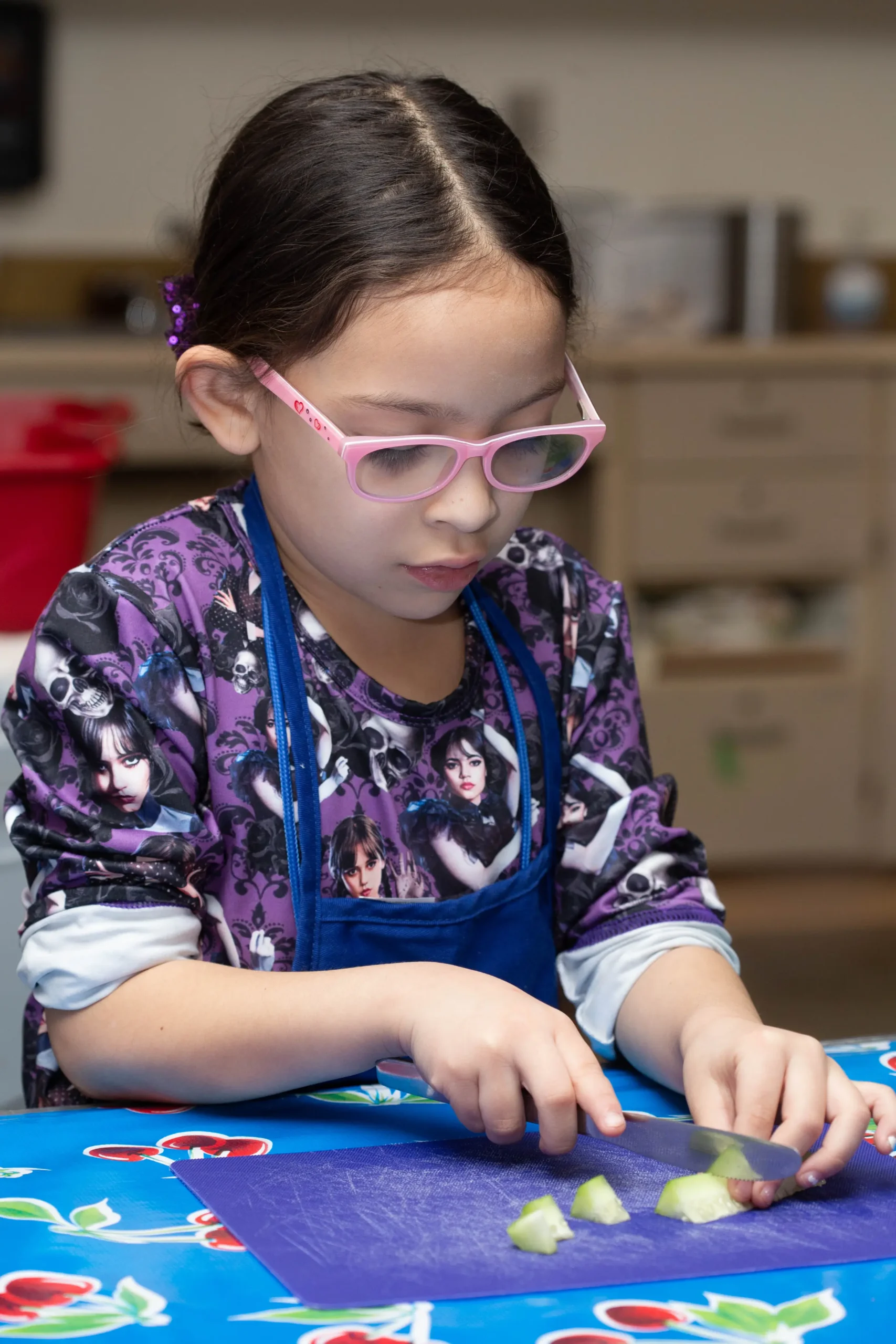
Young kids can practice cutting softer vegetables, like cucumbers or zucchini, with a butter knife. Photo credit: Kerry Sherck
Rachel Shreve is the communications director for Cooking with Kids, a nonprofit organization that provides nutrition education programs in school classrooms and cafeterias in Rio Arriba, San Miguel, and Santa Fe Counties.

